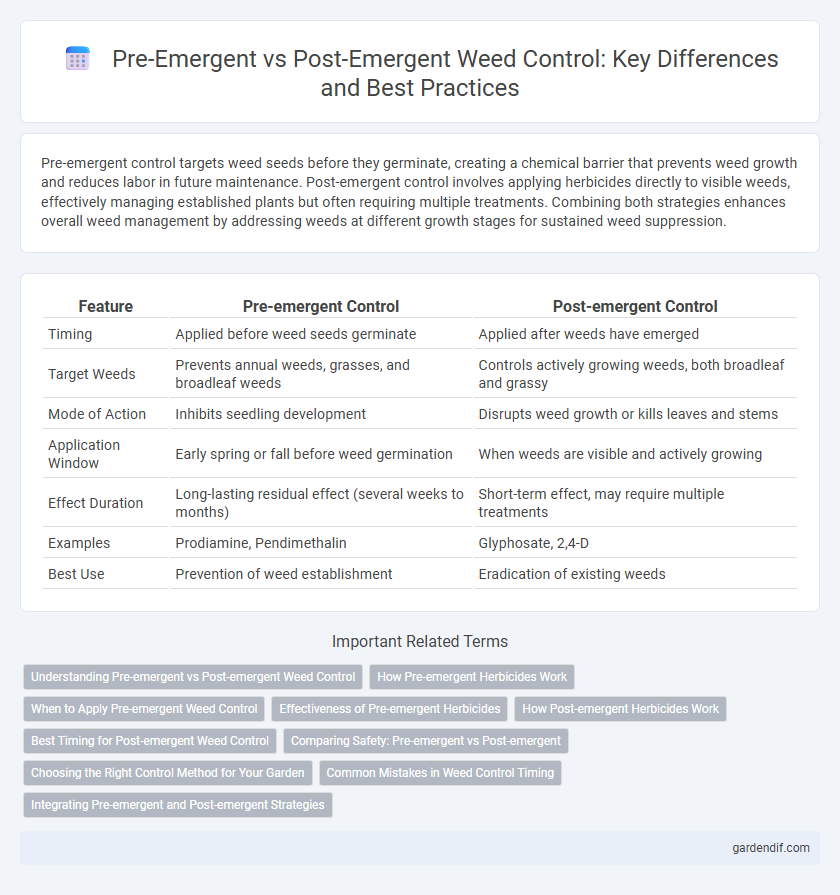
Pre-emergent Control vs Post-emergent Control Illustration
Pre-emergent control targets weed seeds before they germinate, creating a chemical barrier that prevents weed growth and reduces labor in future maintenance. Post-emergent control involves applying herbicides directly to visible weeds, effectively managing established plants but often requiring multiple treatments. Combining both strategies enhances overall weed management by addressing weeds at different growth stages for sustained weed suppression.
Table of Comparison
| Feature | Pre-emergent Control | Post-emergent Control |
|---|---|---|
| Timing | Applied before weed seeds germinate | Applied after weeds have emerged |
| Target Weeds | Prevents annual weeds, grasses, and broadleaf weeds | Controls actively growing weeds, both broadleaf and grassy |
| Mode of Action | Inhibits seedling development | Disrupts weed growth or kills leaves and stems |
| Application Window | Early spring or fall before weed germination | When weeds are visible and actively growing |
| Effect Duration | Long-lasting residual effect (several weeks to months) | Short-term effect, may require multiple treatments |
| Examples | Prodiamine, Pendimethalin | Glyphosate, 2,4-D |
| Best Use | Prevention of weed establishment | Eradication of existing weeds |
Understanding Pre-emergent vs Post-emergent Weed Control
Pre-emergent weed control targets weed seeds before they germinate by creating a chemical barrier in the soil, effectively preventing weed growth at the initial stage. Post-emergent control involves the application of herbicides to actively growing weeds, focusing on eradication after weed emergence. Understanding the timing and herbicide type is crucial for effective weed management and minimizing crop damage.
How Pre-emergent Herbicides Work
Pre-emergent herbicides function by creating a chemical barrier in the soil that inhibits weed seed germination and prevents young weed seedlings from developing roots. These herbicides target crucial biological processes during early seedling growth, such as cell division and root formation, effectively stopping weeds before they emerge above the soil surface. Timely application before weed seeds germinate ensures maximum efficacy in controlling invasive species and maintaining healthy turf or crop growth.
When to Apply Pre-emergent Weed Control
Pre-emergent weed control is most effective when applied early in the growing season, typically before weed seeds germinate and emerge from the soil, usually in early spring or late winter. Timing the application based on soil temperature, around 55degF (13degC), ensures optimal prevention against common annual weeds like crabgrass and goosegrass. Applying pre-emergent herbicides too late, after weeds have already sprouted, significantly reduces their efficacy and may require complementary post-emergent treatments.
Effectiveness of Pre-emergent Herbicides
Pre-emergent herbicides are highly effective in preventing weed seeds from germinating, offering long-lasting control by creating a chemical barrier in the soil that targets seedlings before they emerge. They are most efficient against annual grasses and broadleaf weeds, reducing the need for repeated applications and labor-intensive weed removal. In contrast, post-emergent herbicides act only after weeds have sprouted, requiring timely application to manage visible infestations and often needing multiple treatments for persistent weed problems.
How Post-emergent Herbicides Work
Post-emergent herbicides target weeds after they have germinated by penetrating leaf tissue and disrupting vital physiological processes such as photosynthesis, protein synthesis, or cell division. These herbicides are absorbed primarily through foliage, making them effective against actively growing broadleaf weeds and grasses. Their selective action allows for precise control without harming desired plants when applied correctly.
Best Timing for Post-emergent Weed Control
Post-emergent weed control is most effective when applied during the early growth stages of weeds, typically when they have 2 to 4 leaves, as herbicides can better penetrate and disrupt development. Targeting weeds before they mature enhances control success and reduces seed production, ensuring long-term management. Applying treatment during cooler temperatures and calm weather improves herbicide absorption and minimizes volatilization.
Comparing Safety: Pre-emergent vs Post-emergent
Pre-emergent herbicides are generally safer for the environment and non-target plants as they prevent weed seeds from germinating, minimizing chemical exposure after application. Post-emergent herbicides pose higher risks since they target actively growing weeds, often requiring more careful handling and potentially harming surrounding vegetation. Choosing the right control method depends on crop sensitivity, timing, and desired safety levels for the ecosystem.
Choosing the Right Control Method for Your Garden
Selecting the right weed control method depends on the growth stage of unwanted plants and your garden's specific needs. Pre-emergent herbicides create a chemical barrier in the soil to prevent weed seeds from germinating, making them ideal for controlling annual weeds before they appear. Post-emergent herbicides target actively growing weeds, providing an effective solution for removing established weeds without harming surrounding plants.
Common Mistakes in Weed Control Timing
Applying pre-emergent herbicides after weed seeds have already germinated reduces effectiveness and can lead to persistent weed growth. Post-emergent herbicides are often used too early when weeds are too small or too late when they become resistant, decreasing control efficiency. Timing errors in both approaches result in wasted resources and increased need for repeated treatments to manage weed populations effectively.
Integrating Pre-emergent and Post-emergent Strategies
Integrating pre-emergent and post-emergent weed control strategies maximizes vegetation management by targeting weeds at various growth stages, reducing herbicide resistance and environmental impact. Pre-emergent herbicides prevent weed seed germination, while post-emergent applications eradicate established weeds, ensuring comprehensive coverage. Employing both methods in a timed sequence enhances lawn health, promotes desirable plant growth, and improves long-term weed suppression.
Pre-emergent Control vs Post-emergent Control Infographic

 gardendif.com
gardendif.com